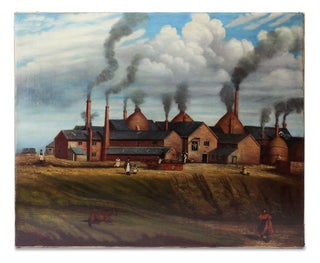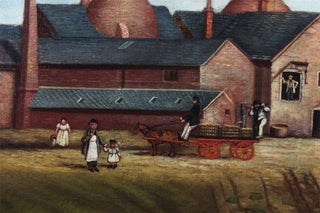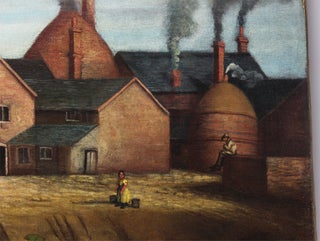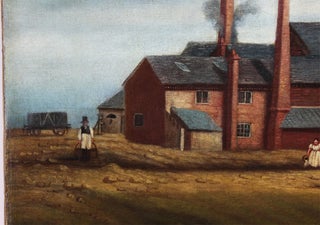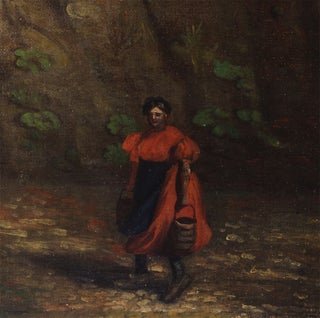1840s to 1860s Bottle Kilns and Pottery Factory Folk Art Painting.
—
Nineteenth century landscape painting documenting a “Pot Bank” or pottery manufactory, an industrial complex of buildings for the commercial manufacture of ceramics. Additionally, ten workers—men women and children, including a supervisor in an elevated loading bay—inhabit the smoke-filled scene, the soot from the kilns and chimneys rising in columns to meet a cloud-filled sky.
This painting depicts three large bottle ovens or kilns for firing ceramics. On the right, there can be seen a smaller glost oven for firing glazed wares. The pot bank depicted here is typical of those seen in Stoke-on-Trent in Staffordshire, England, the center of the English pottery industry.
According to decorative arts and material culture scholar Prof. J. Ritchie Garrison, the painting is likely English, painted in the 1840s–1860s, and depicts a manufactory similar to a surviving 19th century pot bank maintained by the Gladstone Pottery Museum in Staffordshire. He describes the scene in the painting in this way:
The long low warehouses were where the firm housed various processes used in production: molds for slip casting, wheels for throwing pots, jollying equipment for standardizing forms, facilities for making saggars into which the pots were placed for firing, and the all-important shop for refining and processing clays. The tall square chimneys were for heating and for the steam engine that was typically involved in mixing the clays… The pit in the foreground may actually have been a used up coal seam as the general ratio was as much as 10 tons of coal to one of clay in order to run a pot bank: the point being that the important geography was the coal seam with the clay generally imported from various parts of the U.K. (Garrison)
The pit was also where “wasters” or very defective pottery pieces were tossed away. The labor of several of the workers seen in the painting is oriented toward this pit, the men, women, and children moving toward it carrying buckets possibly containing wasters. Prominent is the center is a man driving a horse-drawn wagon and, behind him in the upper doorway or loading bay, a male supervisor. The wagon appears to be carrying open-top, slat-sided crates packed with what appears to be straw, this workman likely transporting finished wares—a clever simultaneous depiction of industry and commerce.
It is curious to note that some of the workers seem to be posed or staged, a few even looking directly at the viewer. This documentary quality is vaguely photographic and lends an “on-the-spot” immediacy to the painting. A very unusual subject to find portrayed in this manner.
Description: 1840s to 1860s Bottle Kilns and Pottery Factory Folk Art Painting.
[Likely Great Britain. ca.1840s–1860s]. Oil on Canvas. Untitled [Landscape with Pot Bank]. 62cm x 76cm unframed. (Approx. 241⁄2 x 30 inches). Professionally cleaned, conserved and re-lined (full treatment report with photo documentation available on request).
[3726676]Price: $12,500.00

![[3726676] 1840s to 1860s Bottle Kilns and Pottery Factory Folk Art Painting. Unkwn.](https://rareamericana.cdn.bibliopolis.com/pictures/3726676.jpg?width=768&height=1000&fit=bounds&auto=webp&v=1590965187)
